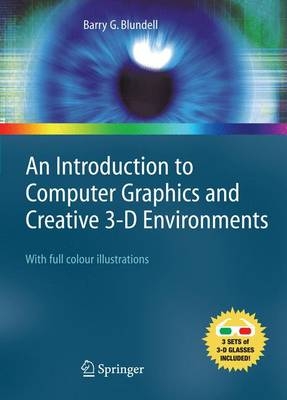
An Introduction to Computer Graphics and Creative 3-D Environments
Springer London Ltd (Verlag)
978-1-84996-711-2 (ISBN)
- Titel ist leider vergriffen;
keine Neuauflage - Artikel merken
This book introduces the fundamentals of 2-D and 3-D computer graphics. Additionally, a range of emerging, creative 3-D display technologies are described, including stereoscopic systems, immersive virtual reality, volumetric, varifocal, and others. Interaction is a vital aspect of modern computer graphics, and issues concerning interaction (including haptic feedback) are discussed. Included with the book are anaglyph, stereoscopic, and Pulfrich viewing glasses. Topics covered include: - essential mathematics, - vital 2-D and 3-D graphics techniques, - key features of the graphics, - pipeline, - display and interaction techniques, - important historical milestones. Designed to be a core teaching text at the undergraduate level, accessible to students with wide-ranging backgrounds, only an elementary grounding in mathematics is assumed as key maths is provided. Regular 'Over to You' activities are included, and each chapter concludes with review and discussion questions.
Preface.-Acknowledgements.-Setting the Scene.-Introduction.- The Nature of Computer Graphics.- The Evolution of Computer Graphics.- Vector and Bitmapped Graphics: Image Refresh.- Display Hardware.- Encoding the Third Dimension.- Discussion.- Review Questions.- Investigations.- Feedback to Review Questions.- A Maths Primer.- Introduction.- Cartesian, Polar and Homogenous Coordinate Systems.-The Line.- Vectors in a 2D Space.- Matrices.- Concerning Curves.- Forming a Parabola Using Three Points: de Casteljau Algorithm.- Discussion.- Review Questions.- Feedback to Review Questions.- Images in a 2-D Space.- Introduction.- Some Basic Considerations.- Transformations Using 2 by 2 Matrices.- Combined Transformations Using 2 by 2 Matrices.- Homogenous Transformations in a 2D Space.- Concerning Graph Theory.- Clipping Points and Lines.- Clipping Polygons.- Discussion.- Review Questions.- Feedback to Review Questions.- Curves in a 2-D Space.- Introduction.- A Little Calculus.- Interpolation.- Bezier Curves.- Spline Functions and B-Splines.- Continuity.- Discussion.- Review Questions.- Feedback to Review Questions.-Interfacing with the Visual System.- Introduction.- The Eye.- Cues to Depth.- An Overview of Various Pictorial Cues.- Oculomotor Depth Cues.- Binocular Cues .- Discussion.- Review Questions.- Feedback to review Questions.- Into the Third Dimension: Transformations.-Introduction.- Basic Transformations in 3-D.- The Vector Product.- Combing Transformations.- Perspective Revisited.- Frames of reference and the Virtual Camera.- Discussion.- Review Questions.- Feedback to Review Questions.- 3-D Graphics: Representation.- Introduction.- Polygonal Models.- The B-rep Approach.- A Little Maths: The Plane.- Polygonal Representation: Some General Remarks.- Surface Construction Using Bezier Patches.- Constructive Solid Geometry.- Discussion.- Review Questions.- Feedback to Review Questions.- 3-D Graphics: Mainly Rendering.-Introduction.- Unification: The World Coordinate System.- The Viewing Volume.- Culling, Clipping and the Perspective Projection.- Mapping to a Viewport.- Clipping for Opacity.- Shading and Colour.- Ray Casting and ray Tracing.- Discussion.- Review Questions.- Feedback to Review Questions.- Creative 3-D Display Systems.-Introduction.- Creative 3-D Display Systems: General Characteristics.- Stereoscopic Techniques.- Stereoscopic Systems: Supporting Motion Parallax.- Volumetric Display Techniques.- Varifocal Systems.- Holographic Systems.- Discussion.- Review Questions.- Feedback to Review Questions.- Interaction and Haptic Feedback.- Introduction.- Concerning Interaction.- Somatosensory Perception.- Traditional Interaction.- haptic Feedback.- Discussion.- Appendix A: Maths: Some Useful Results.- Appendix B: The Curvature of a Varifocal Mirror.- Appendix C: The Scalar Product.- Appendix D: Concerning the Plane.- Feedback to Selected OTU Exercises.- References.- Index
| Erscheint lt. Verlag | 13.10.2010 |
|---|---|
| Zusatzinfo | 21 black & white illustrations, 227 colour illustrations, 12 black & white tables, biography |
| Verlagsort | England |
| Sprache | englisch |
| Maße | 178 x 235 mm |
| Gewicht | 856 g |
| Einbandart | Paperback |
| Themenwelt | Kunst / Musik / Theater ► Design / Innenarchitektur / Mode |
| Informatik ► Grafik / Design ► Film- / Video-Bearbeitung | |
| Informatik ► Software Entwicklung ► User Interfaces (HCI) | |
| Informatik ► Weitere Themen ► CAD-Programme | |
| ISBN-10 | 1-84996-711-3 / 1849967113 |
| ISBN-13 | 978-1-84996-711-2 / 9781849967112 |
| Zustand | Neuware |
| Informationen gemäß Produktsicherheitsverordnung (GPSR) | |
| Haben Sie eine Frage zum Produkt? |
aus dem Bereich


